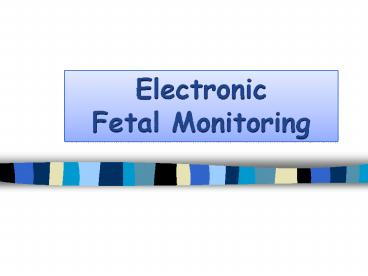Electronic Fetal Monitoring Standard of Care - PowerPoint PPT Presentation
1 / 39
Title:
Electronic Fetal Monitoring Standard of Care
Description:
Monitoring Uterine Activity Frequency Duration Intensity Resting tone Categorizing Fetal Monitor Strips ... through the umbilical vein to fetal circulation. – PowerPoint PPT presentation
Number of Views:614
Avg rating:3.0/5.0
Title: Electronic Fetal Monitoring Standard of Care
1
Electronic Fetal Monitoring
2
Fetal Oxygenation
3
Placental Physiology
- Maternal blood flows through the uterine arteries
into the intervillous spaces then return
through uterine veins to maternal circulation - Fetal blood flows through the umbilical arteries
into the villous capillaries and returns through
the umbilical vein to fetal circulation. - Exchange of blood gases depends on an
unobstructed blood flow through the placenta.
4
Uteroplacental exchange
- As the myometrium contracts, the flow of
oxygenated blood through the uterine artery may
be decreased. - Therefore, the fetus may have less oxygen
available.
5
Regulation of Fetal Heart Rate
- Autonomic nervous system
- Baroreceptors
- Chemoreceptors
- Adrenal Gland
- Central Nervous System
6
Methods of Electronic Monitoring
7
Methods of Fetal Monitoring
8
Auscultation by Doppler
9
External Monitoring
The ultrasound device is placed over the area of
the fetal back. This device transmits information
about the FHR.
The tocodynamometer (toco) is placed over the
uterine fundus. The toco provides information
that can be used to monitor uterine contractions.
10
Internal Monitoring
- Methods
- Scalp (spiral) electrode (SE)
- Intrauterine Pressure Catheter (IUPC)
- Criteria for Internal Monitoring
- Amniotic membranes must be ruptured
- Cervix dilated 2 cm.
- Presenting part down against the
- cervix
11
Internal Monitoring
12
Monitoring Patterns
13
Baseline Fetal Heartrate Normal
Pattern
- Baseline FHR 120 160 bpm
14
Patterns
- Tachycardia baseline above 160 BPM
- RT maternal fever, fetal hypoxia, intrauterine
infection, drugs - Bradycardia baseline below 110 BPM
- RT profound hypoxia, anesthesia,
beta-adrenergic blocking drugs
15
Variability
- Normal/ increased variability or irregularity of
a cardiac rhythm. - Absence or decreased variability, or a smooth
flat baseline, is a sign of fetal compromise.
16
Causes of Decreased Variability
17
Accelerations
18
Periodic changes in the FHR
- Accelerations increase in the fetal heart rate
with a return to baseline. - Indication of fetal well-being is an acceleration
of 15 bpm for 15 seconds.
19
Reassuring Acceleration Pattern
Baseline fetal heart rate is 120-160 with
preserved beat-to-beat variability. Accelerations
last for 15 or more seconds above baseline, and
peak to 15 or more bpm.
20
Decelerations
21
Periodic changes in the FHR
Decelerations
- Early related to head compressions.
Interventions not necessary - Variable related to cord compression.
Interventions vary, but focus on position
changes. - Late related to uteroplacental insufficiency.
Most ominous and need immediate attention.
22
Early Deceleration
The onset and return of the deceleration coincide
with the start and end of the contraction.
Fetal Heart Rate
Contractions
23
Early Decelerations
- Related to Head Compression
- Intervention
- No intervention necessary. Just continue to watch
for any changes.
24
Variable Deceleration
- Variable decelerations are variable in duration,
intensity, and timing
25
Variable Decelerations
- Related to cord compression
- Intervention
- Reposition
- Amnioinfusion
26
Late Deceleration
- The fetal heart tones return to the baseline
AFTER end of contraction
27
Late Decelerations
- Related to decreased uteroplacental perfusion
28
Nursing Care for Late or Prolonged Decelerations
- Stop the Pitocin
- Reposition - Turn woman to a side-lying position,
or knee- chest position. Avoid supine position - Increase rate of the mainline IV
- Administer oxygen by mask at 10 L/min.
- Give Terbutaline sub-q.
29
Nursing Care
- Notify the primary care provider
- If condition does not improve, then prepare for
immediate delivery
30
Fetal Scalp Stimulation
- Gently stroke or massage fetal scalp for 15 sec.
during a vaginal examination - Assess fetal tracing for signs of accelerations
of 15 bpm for 15 sec. - This is a sign of fetal well-being
31
Cord Blood Analysis
- Criteria
- Significant abnormal FHR
- Meconium stained amniotic fluid
- Infant is depressed at birth
- Small amount of blood obtained from the umbilical
artery and vein - Arterial samples are the best indicator of fetal
oxygenation
32
Review
33
Monitoring Uterine Tone
- External monitoring (toco)
- Mild
- Moderate
- Firm
- Internal monitoring (IUPC)
- Pressure in mmHg
34
Monitoring Uterine Activity
- Frequency
- Duration
- Intensity
- Resting tone
35
Categorizing Fetal Monitor Strips
36
- Category I
- Category II
- Category III
- See handout
37
Review
38
Review
39
Review






























![[PDF] Mosby’s® Pocket Guide to Fetal Monitoring 9th Edition Android PowerPoint PPT Presentation](https://s3.amazonaws.com/images.powershow.com/10081934.th0.jpg?_=20240719044)
